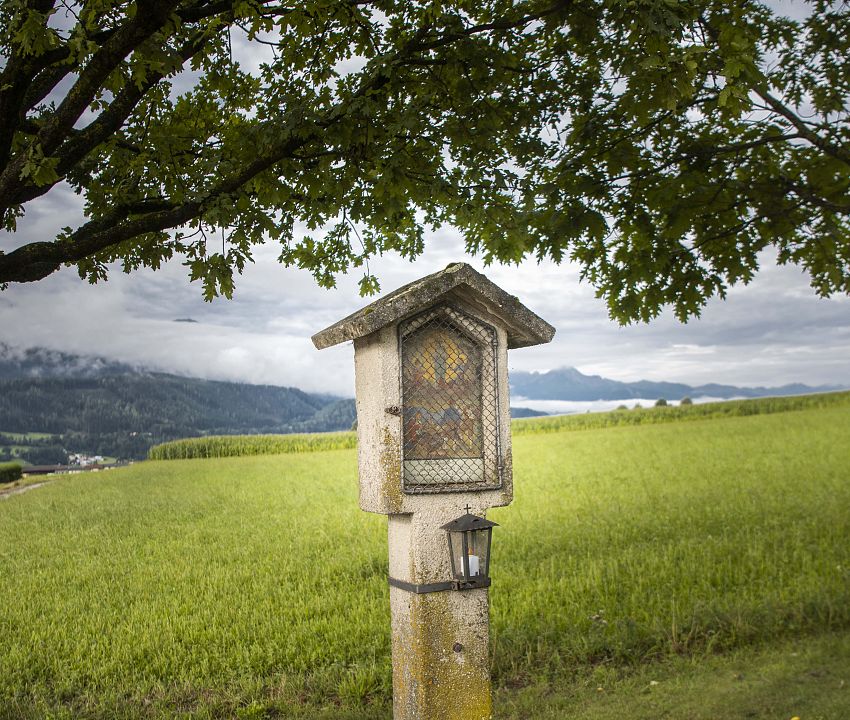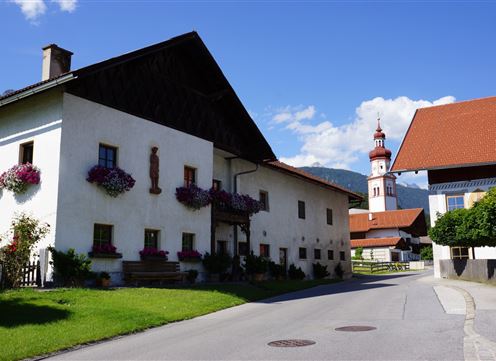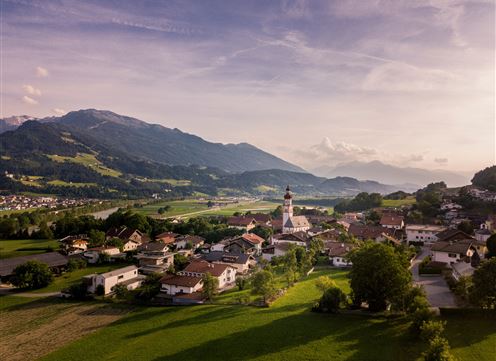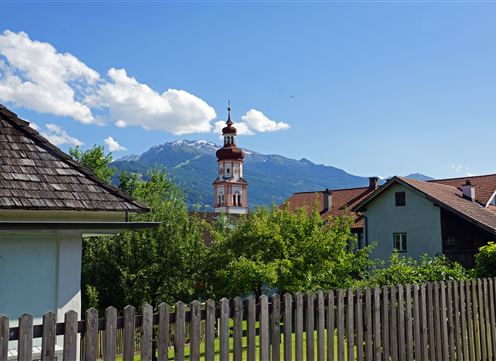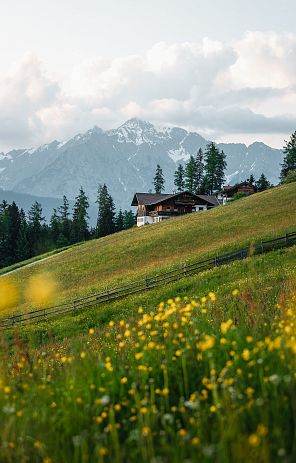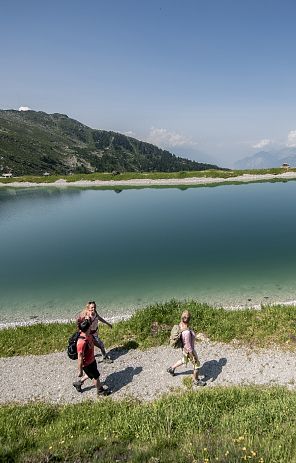Powerful Place. Place to the Three Oaks in Mils
Anyone taking a break on the wooden bench under the three trees will probably immediately notice that there are not three oak trees here. To be more precise, there are only two oaks and an ash tree. So where does the name "Platz zu den Drei Eichen" come from? This much can be revealed in advance: as so often in Tyrol, it has to do with the Mother of God!
You should know that the oak tree has always played an important role in Mils. The hiking trail from Mils to Baumkirchen shows us this vividly, as it is still lined with oak trees on the right-hand side today.
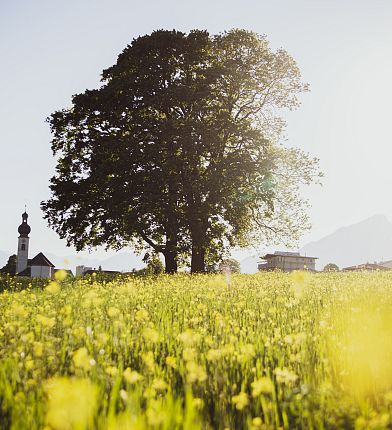
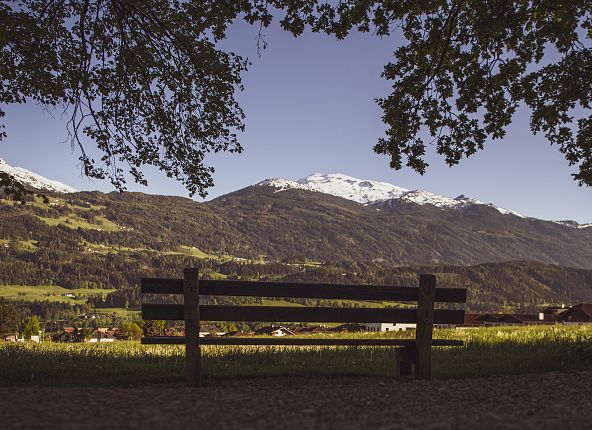
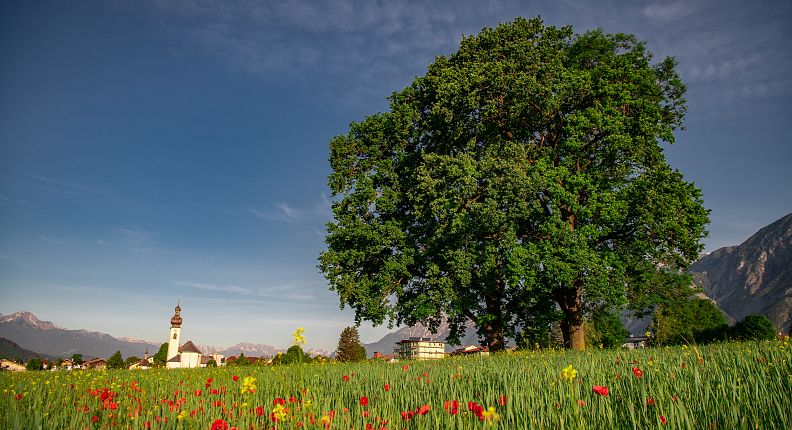
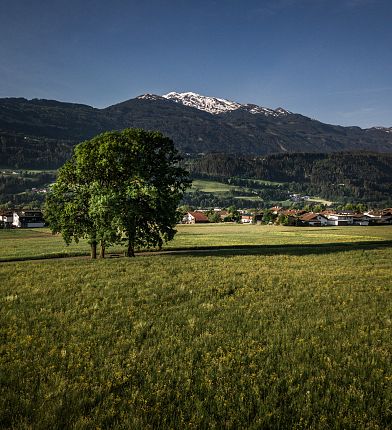
The Drei Eichen power place at a glance
- The pilgrimage in Mils
- The power of oak
- Wayside shrine as a reminder
- Hiking along the oaks
- Hunting lodge Hirschenlust
- Mils: home to famous personalities
- Village with tradition: the Milser Matschgerer
The oak as a tree of life
The Celts already venerated the oak tree in a special way. Historians have recorded that the Celts did not perform any ritual acts without oak leaves. The oak also has a special place in Christianity, as it is regarded as the tree of life. The durable wood and long life of the tree stand for eternal life and eternal salvation. The oak can be found in Gothic and early modern times, for example on bible covers.
We learn from an advertising brochure from 1906 by Dr. Otto Kölner, doctor and owner of the Grüneggerhof, that the oak also played an important role in tourism in Mils. It reads as follows:
"Northeast of the salt works town of Hall, about 1 to 1 1/2 kilometers from it as the crow flies, lies the little village of Mils in the middle of a grove of fruit trees and oaks at the foot of the slopes of the Gnadenwald that descend to the Inn Valley. This little village with its 70 to 80 clean houses, which look out of their orchards in a friendly manner, has around 600 inhabitants. Some of the men are employed at the Hall salt works, some in the salt mines, while the others farm. The soil of Mils is not considered particularly fertile, nevertheless the meadows and fields are beautifully cultivated, testifying to the diligence of the inhabitants."
The legend of Our Lady of Mils
In Christianity, the oak has always been associated with the faithful Saint Mary. It is therefore not surprising that the legend of Our Lady of Mils is closely linked to the oak tree.
It is reported that farmers came across a "Piltnus" - an image of the Virgin Mary - while felling wood. It is said to have been a wooden sculpture located in the middle of a mighty oak trunk.
Two dates are given for this miraculous find: The year 908 and the year 992. Witness to this is the so-called "Auffindungsbildstöckl", which can no longer be found in its original location today, but at a fork in the road halfway between Mils and Baumkirchen. However, until the 19th century, an iron cross between the three remaining oak trees marked the original location of the discovery tree. This place may have been the birthplace of the three oaks. However, this can no longer be proven today and would have to be researched among the older generation of the Milser population.
The fact is that centuries ago there were extensive oak forests in this area, the remains of which can still be seen on the southern edges of the Milserwald forest and on the slope of the Schuttkegel in the direction of Baumkirchen.
Today we no longer have the original, probably Romanesque image of Our Lady of Mils. This probably fell victim to a church fire in 1415. The Madonna figure now on the left side altar probably dates from around 1420, as indicated not only by the still recognizable soft Gothic style of the figure, but also by a deed of donation from 1694 by Baroness Maria von Schneeburg for the chapel of mercy formerly attached to the church. It states that the image has been venerated for 274 years, from which the year 1420 can be calculated.
Locations of the Mother of God
The statue of Our Lady was originally located in a niche in the presbytery of the church, but was moved to a chapel attached to the parish church in 1696. In 1762, the miraculous image was placed on the high altar. In 1785, the mantle of the statue had to be removed by order of Joseph II. The inventory of 1767 mentions 13 garments for the Mother of God and 17 garments for the Child Jesus! These items and many other votive and silver offerings - it must have been a valuable church treasure - had to be handed over to the Thaur district court on the orders of Joseph II. But as early as 1800, after the repeal of the Josephine Laws, Father Popp had a new gold-embroidered skirt made for the image of grace by the Ursulines in Innsbruck for 121 guilders. After the church fire, it was transferred in solemn procession to St. Anne's Church. After the completion of the new church building, the miraculous image seems to have been placed on the left side altar, where it still stands today. In 1858 it was once again stripped of its "plaited fashion", restored by the sculptor Müller from Hall and led in solemn procession from the Franciscan church in Hall to Mils on February 20, 1858. The last restoration of the miraculous image took place in 2001.
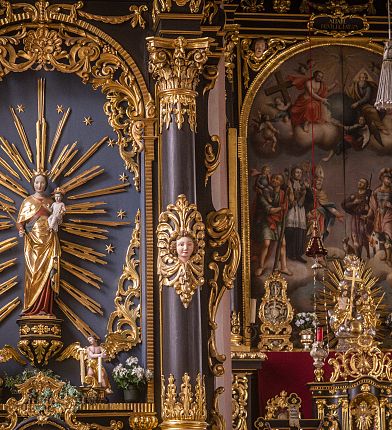
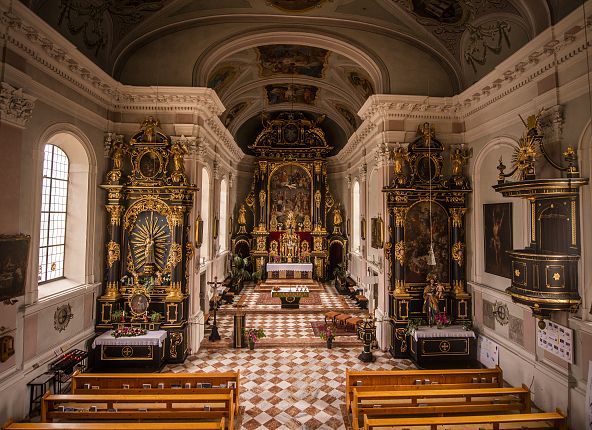
Finding wayside shrine
The pilgrimage in Mils
In the High Middle Ages, Mils was certainly one of the most important pilgrimage centers in the Inn Valley. People told stories of answered prayers and these were probably the decisive factor for the strong pilgrimage movement (in some cases even from Bavaria and South Tyrol). Famous rulers and members of the House of Habsburg also visited Our Lady of Mils with Baby Jesus.
The second wife of Duke Frederick with the empty purse, Duchess Anna, came here in 1424. When almost all of Hall fell victim to a town fire in 1447, the town council vowed to make an annual pilgrimage to "Our Lady" in Mils on the Thursday before Palm Sunday.
Emperor Maximilian is said to have donated velvet and jewelry to clothe the Mother of Mercy in Mils around 1500. Archduchess Anna Katharina, the second wife of Ferdinand II, often stayed in the later burnt down hunting lodge Hirschenlust Grünegg in Mils and venerated the Madonna of Mils. The Servites, who had set up their domicile in Grünegg Castle for several years after the burning of their monastery in Innsbruck in 1620, also contributed greatly to the importance of the pilgrimage to Mils as a religious order dedicated to the veneration of the Virgin Mary. Archduchess Elisabeth is known to have visited the Madonna of Mils in 1783.
The pilgrimage came to an end with the church fire of 1791, although this time the statue of the Madonna was saved from the flames. The appearance of the Absam image of grace coincided with the construction of the new church. This new place of grace eventually overtook Mils.
In 1908 there was a large "secular celebration" to mark the 1000th anniversary of the pilgrimage image with the Abbot of Wilten and the music bands of Mils, Rinn and Volders. Today, the pilgrimage to Mils has practically died out, apart from the annual pilgrimage to Mils organized by the parish of Baumkirchen on the Tuesday before Ascension Day. Nevertheless, the Mils miraculous image is still highly venerated by the villagers, as can be seen from the many candlelights burning in front of the altar of grace.
Hunting lodge Hirschenlust Grünegg
The Hirschenlust hunting lodge no longer exists today. It was located in the Grünegg district, which is why it often bore this nickname. The area around the castle was primarily used for hunting, as the extensive forests at the foot of the Gnadenwald forest and above the village of Mils were home to all kinds of noble game. The hunting-loving princes of Tyrol appreciated this and often traveled from Innsbruck to indulge their passion for hunting here.
According to the parish chronicle of Mils, Hirschenlust is said to have existed as a hunting lodge as early as 1400, which the sovereign princes Frederick IV with the Empty Pocket and Sigmund the Coin-rich would have liked to mention as a hunting location in the Halltal valley.
Grünegg is first mentioned in documents under Archduke Ferdinand II. After the death of his beloved wife Philippine Welser, with whom he primarily resided at Ambras Castle, he was increasingly drawn to the area around Mils, mainly to escape his grief and the memories of his beloved wife.
In order not to have to travel the long way to Innsbruck every day, he built the noble residence "Hirschenlust Grienegg" in 1580 instead of the hunting lodge, which must have had quite extensive rooms, he called 'Hirschenlust Grienegg'.
In addition to the small castle, it also included bird huts, residential buildings and numerous farm buildings. The eye-catching barn of the Schiechlbauer, today Oberdorf 12, with its shield coat of arms and stone-framed arched gate was probably also part of Grünegg Castle. The building was probably erected towards the end of the 16th century and may have served as a salt or weapons store. Archduke Ferdinand II gave Grünegg Castle to his second wife Anna Katharina Gonzaga of Mantua. When she entered the regular house of the Servite nuns in Innsbruck in 1612, Grünegg became the property of the order. The castle burned down completely in 1686. The ruins of the walls were later used as a quarry, especially for the new Widum in Mils built around 1779 and the bathhouse in Baumkirchen built in 1840.
What is the connection between Hirschenlust and our place of power?
This question is of course very justified. Until around 1940, four old oak trees still marked the location of the castle, but these have since disappeared. It is assumed that the site of the three oaks could also be at this location. As mentioned at the beginning, the actual square to the east of the church is not only planted with oaks, but also with a lime tree. However, this is only conjecture.
Treasures on Grünegg - Legends of Hirschenlust
Numerous stories have circulated since time immemorial about mysterious passages connecting the noble residences of Mils and even reaching over to the other side of the Inn to Friedberg Castle in Volders, the Glockenhof in Tulfes and the Kolbenturm in Volderwald. The existence of these passages was doubted for a long time. At the beginning of the 20th century, however, parts of such passages were actually discovered, which had apparently been created in the Middle Ages to enable the nobles of Mils to escape to the fortified town of Hall in the event of war.
Our hunting lodge is also said to have had such underground passages. Legends of treasures that are said to be located around the former castle have been preserved to this day:
The cellars and vaults of the Hirschenlust hunting lodge are said to still be very well preserved and contain precious treasures. Many had already searched for them, but in vain. The secret entrance to the vaults is said to be hidden in the castle grounds on the Grünegg. An old farmer once discovered this entrance by chance and was about to take the few stairs down to the cellar. But then the midday bells rang and he went home. But when he returned, the stairs and cellar had disappeared without a trace.
The wife of a blacksmith who lived on the heath is also said to have once come very close to this cellar. One Sunday morning, this woman was walking across the castle field with her small child when she came across a nun with a huge bunch of keys. She beckoned the woman to follow her and went down some stairs into a cellar. The woman and her child had already followed her down a few steps when they saw a dog with a fiery maw in the depths. Fearing for her child, the woman hurried upstairs and set the child down next to the entrance to venture into the cellar alone. But then there was a bang and the cellar and the nun suddenly disappeared. The innocent child could have lifted the treasure, but the woman had wasted this unique opportunity through her fearfulness.
The nun usually only appeared in the evenings at so-called holy times, when she used to wander around the ruins of Hirschenlust with her bunch of keys. Once a farmer found three silver coins lying on one of the stones, took them and used them for his own purposes. However, he could not enjoy the money for long, as he suddenly fell seriously ill and no remedy could help him. It was only when he had masses read for the amount he had found, as the nun presumably wanted, that he regained his former health.
Christine Zucchelli - Mysterious Hall
